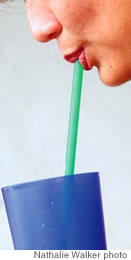Drinking To Prevent The Worst Pain

Friday - July 18, 2007
| Share
 Del.icio.us
Del.icio.us

|
One thing I hope to never experience is kidney stones.
I remember sitting in the emergency room a few years ago for a minor basketball injury when I heard yowling cries coming from a neighboring room.
I listened for what seemed like hours as this person loudly moaned and groaned and shouted just about every vulgar word in the dictionary.
Finally a nurse came in and I could not help but ask if he was OK. “Yeah, he’s passing kidney stones,” she replied.
I left the hospital and never came across those words - kidney stones - again until a couple of months ago when a friend and then a co-worker both had it.
“It feels like something ripping through your ureter,” is how my co-worker describes it. “Like a serrated knife.”
OK, well I don’t know about you, but I sure don’t ever want to have kidney stones. So, what can be done to prevent it?
“The way to prevent stone formation is to drink water, plenty of it, preferably more than 2.5 liters per day,” says Dr. David Chiahon Wei, assistant clinical professor at the University of Hawaii John A. Burns School of Medicine. “If a person were to form kidney stones recurrently despite good hydration, he or she should refrain from eating certain types of food that cause his or her particular type of stone, such as peanuts and spinach for calcium oxalate stone and organ meat for uric acid stone.
“Also, certain types of medication could prophylactically prevent stone formation, for example, thiazide diuretics for calcium stone and allopurinal for uric acid stone.”
According to Dr. Wei, kidney stones are the stones that form in the kidney and are the result of the deposit or aggregation of various types of concentrated electrolytes or chemicals in the urine.
When the stones are “matured” they fall into the renal collection system, and while in their respective location can remain the same size, become bigger or migrate into the ureter to cause obstruction. It is at this point when renal colic (or kidney pain) usually develops.
“The symptoms of having kidney stones are variable,” says Wei. “It primarily depends on the location and size of the stone and how obstructive the stone is to the flow of urine. For example, a 2 millimeter stone in the lower pole calyx that is not obstructing the outflow of urine and hence will not cause any symptoms. Without radiographic study, the person who has this particular stone will not even know that he has a stone in his kidney.
“On the other hand, if a stone has migrated into the uretero-pelvic junction or into the ureter, it may obstruct the out-flow of urine from the kidney and as a result, the urine generated has no place to drain to but to stay in the same place and to exert back pressure on the kidney. At this point, the affected person will experience severe back pain or flank pain. Some describe it as worse than having a baby.
“Changes in body position usually will not be enough to alleviate the pain. On occasion, a person will develop bloody urine and irritative voiding symptoms, such as urinary frequency or urgency. In the worse case scenario, especially in a patient with a history of diabetes or being immunocompromised, he or she may develop urosepsis which will lead to hypotension, tachycardia and high grade fever.”
If you or someone you know is developing flank pain or suspect to be having a kidney stone “attack,” see a doctor immediately. Treatment will depend on the stones’ location, size and constitution.
I personally hope to never get to that point. And for someone who hardly drinks water (sometimes I’ll go through an entire day without a glass), this has convinced me to drink up.
“For the most part, a person develops kidney stone due to dehydration,” notes Wei. “It has been reported if a person were to have 2,000 cc or more urine output per day, the chance of that person forming stone becomes very low. The average person here in Hawaii probably only has about 1,000 to 1,500 cc of urine output per day.
“Diet plays an important role as well. People who like to eat peanuts and green leafy vegetables such as spinach and drink milk or eat dairy product tend to develop calcium oxalate stone. On the other hand, people who like to eat organ meat will develop uric acid stone. Incidentally, the local Filipino diet tends to be rich in organ meat and as a result, local Filipinos are likely to develop uric acid stone and gout disease.
“Also, if a patient has a history of recurrent urinary tract infection, he or she (more likely she) will develop staghorn calculi made of struvite, a type of stone that fills up most or the entire renal collecting system.
“Finally, certain rare genetic diseases could cause a person to form the cystine stone which is perhaps the hardest kidney stone.”
E-mail this story | Print this page | Comments (0) | Archive | RSS Comments (0) |
Most Recent Comment(s):













